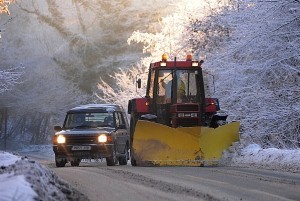Winter driving is a significant hazard for workers

Winter weather is largely to blame for the increased threat of highway and road accidents during the colder months. Workers can be injured during trips to and from a worksite or while carrying out other tasks, so employers should stress the importance of being vigilant on the road. The U.S. Department of Transportation's Federal Highway Administration (FHWA) estimates that each year, there are an average of 583,400 crashes and 181,300 injuries due to snow, sleet, hail, and slush on the road. Consider the following tips for educating staff members about these conditions.
The three Ps
The Occupational Safety and Health Administration (OSHA) advocates that employers teach their workers to follow the rule of the three Ps when driving in the winter. They are:
• Prepare: prepare for the trip before it begins
• Protect: be sure that normal safety requirements are met
• Prevent: avoid actions that increase the chances of an accident
Prepare
While the condition and functionality of vehicles need to be guaranteed no matter the time of year, there are certain features that are particularly important in the winter.
Windshield wipers are crucial for clearing falling snow and melted ice out of a driver's field of vision. Wipers need to be checked much more frequently in the winter, as they are key to preventing accidents. Damaged or worn wipers need to be replaced immediately, or a vehicle shouldn't be driven.
All windows need to be clear of ice and snow before a trip begins, so an ice scraper should be present in all vehicles during the winter. A scraper should come with a brush to make it easier to remove loose snow. Wiper fluid is an important backup supply in case ice begins to build on a windshield while driving.
Tire treads need to be in good condition to drive on icy or snow-covered roads. Tires with treads that are worn down or bald should be replaced as soon as possible.
Some supplies should be kept in cars, trucks, and vans for the duration of the winter. They include an extra supply of antifreeze, a flashlight, jumper cables, a snow shovel, a first aid kit, and blankets.
Protect
Safety protocols should always be followed by drivers, but extra vigilance is necessary to drive during the winter. This means that seat belts should always be worn and any additional requirements for trucks, backhoes, and cargo transportation vehicles should be strictly observed.
Drivers who are inexperienced with winter road conditions should practice steering on ice and snow, preferably in the company of an experienced driver.
Employers can help to make the identification of broken-down or disabled vehicles easier. Bright, reflective tape can be placed on antennae as well as the bumpers and hoods of company cars and trucks. This will help prevent them from being hit by other drivers when pulled to the side of the road. In these situations, workers should also activate their hazard flashers and activate the interior dome lights for maximum visibility in snowstorms or when sleet is falling. Flares, warning triangles, booster cables, and other emergency roadside safety equipment should be carried in company vehicles for quick use in the event of an emergency.
Prevent
Driving in the winter means that the distance between vehicles on the road should be increased to reduce the risk of skidding and brakes locking up. Additionally, all cars and trucks should be driven much more slowly than they normally would be in ideal conditions, no matter the speed limit that's posted.
It's easy for workers to become tired or fatigued in the wintertime. Shoveling snow and walking on icy surfaces adds to this exhaustion, which can be made even worse by the stress of careful winter driving. Workers should avoid getting behind the wheel of a vehicle if they are overtired or exhausted.
Precautions and preparation
If you're an employer whose workers are required to drive in the winter, purchase extra safety supplies in case a vehicle breaks down or is in an accident. Safety vests can help identify employees as they assess these situations, while safety glasses and warm work gloves can help when making repairs or while waiting for help. In addition, avoid sending staff members out to drive without first making sure that they have warm clothes in case their vehicle breaks down on the way.


